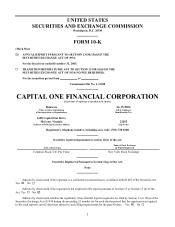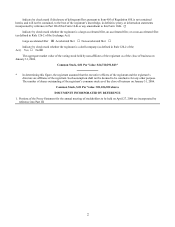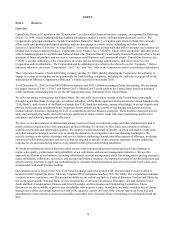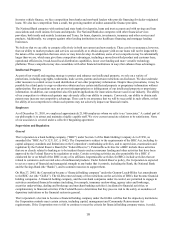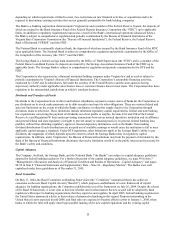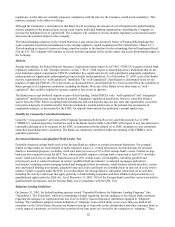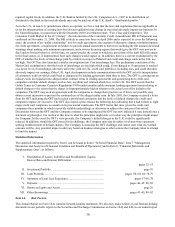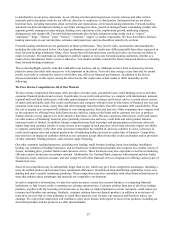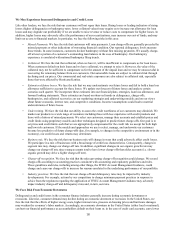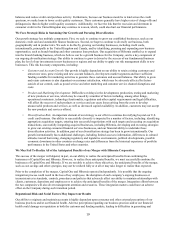Capital One 2005 Annual Report Download - page 20
Download and view the complete annual report
Please find page 20 of the 2005 Capital One annual report below. You can navigate through the pages in the report by either clicking on the pages listed below, or by using the keyword search tool below to find specific information within the annual report.depending on which requirements it failed to meet, face restrictions on new financial activities or acquisitions and/or be
quired to discontinue existing activities that are not generally permissible for bank holding companies. re
The Bank is a banking corporation chartered under Virginia law and a member of the Federal Reserve System, the deposits of
which are insured by the Bank Insurance Fund of the Federal Deposit Insurance Corporation (the “FDIC”) up to applicable
limits. In addition to regulatory requirements imposed as a result of the Bank’ s international operations (discussed below),
the Bank is subject to comprehensive regulation and periodic examination by the Bureau of Financial Institutions of the
Virginia State Corporation Commission (the “Bureau of Financial Institutions”), the Federal Reserve, the Federal Reserve
Bank of Richmond (“FRB-R”) and the FDIC.
The National Bank is a nationally chartered bank, the deposits of which are insured by the Bank Insurance Fund of the FDIC
up to applicable limits. The National Bank is subject to comprehensive regulation and periodic examination by the Office of
the Comptroller of the Currency (the “OCC”) and the FDIC.
The Savings Bank is a federal savings bank chartered by the Office of Thrift Supervision (the “OTS”) and is a member of the
Federal Home Loan Bank System. Its deposits are insured by the Savings Association Insurance Fund of the FDIC up to
applicable limits. The Savings Bank is subject to comprehensive regulation and periodic examination by the OTS and the
FDIC.
The Corporation is also registered as a financial institution holding company under Virginia law and as such is subject to
periodic examination by Virginia’ s Bureau of Financial Institutions. The Corporation’ s automobile financing activities,
conducted by COAF and its subsidiaries, fall under the scrutiny of the Federal Reserve and the state agencies having
supervisory authority under applicable sales finance laws or consumer finance laws in most states. The Corporation also faces
regulation in the international jurisdictions in which it conducts business.
Dividends and Transfers of Funds
Dividends to the Corporation from its direct and indirect subsidiaries represent a major source of funds for the Corporation to
pay dividends on its stock, make payments on its debt securities and meet its other obligations. There are various federal and
state law limitations on the extent to which the Banks can finance or otherwise supply funds to the Corporation through
dividends, loans or otherwise. These limitations include minimum regulatory capital requirements, federal and state banking
law requirements concerning the payment of dividends out of net profits or surplus, Sections 23A and 23B of the Federal
Reserve Act and Regulation W there under governing transactions between an insured depository institution and its affiliates,
and general federal and state regulatory oversight to prevent unsafe or unsound practices. In general, federal banking laws
prohibit, without first obtaining regulatory approval, insured depository institutions, such as the Banks, from making
dividend distributions if such distributions are not paid out of available earnings or would cause the institution to fail to meet
applicable capital adequacy standards. Under OTS regulations, other limitations apply to the Savings Bank’ s ability to pay
dividends, the magnitude of which depends upon the extent to which the Savings Bank meets its regulatory capital
requirements. In addition, under Virginia law, the Bureau of Financial Institutions may limit the payment of dividends by the
Bank if the Bureau of Financial Institutions determines that such a limitation would be in the public interest and necessary for
e Bank’ s safety and soundness. th
Capital Adequacy
The Company, the Bank, the Savings Bank, and the National Bank (“the Banks”) are subject to capital adequacy guidelines
adopted by federal banking regulators. For a further discussion of the capital adequacy guidelines, see page 49 in Item 7
“Management’ s Discussion and Analysis of Financial Condition and Results of Operations—Capital Adequacy” and pages
90-92 in Item 8 “Financial Statements and Supplementary Data—Note 18—Regulatory Matters”. The Banks were well
capitalized under these guidelines as of December 31, 2005.
Basel Committee
On May 11, 2004, the Basel Committee on Banking Supervision (the “Committee”) announced that it has achieved
consensus on the new Basel Capital Accord (“Basel II”), which proposes establishment of a new framework of capital
adequacy for banking organizations; the Committee published the text of the framework on July 26, 2004. Despite the release
of the Basel II framework, it is not clear at this time whether and in what manner the new accord will be adopted by bank
regulators with respect to banking organizations that they supervise and regulate. In April 2005, federal banking regulators in
the United States announced a delay in their release of proposed rulemaking in this regard. Proposed rulemaking in the
United States is now expected in mid-2006, and final rules are expected to become effective prior to January 1, 2008, when
banks to which the rules will apply must begin parallel running of the new capital regulations and the existing capital
11


